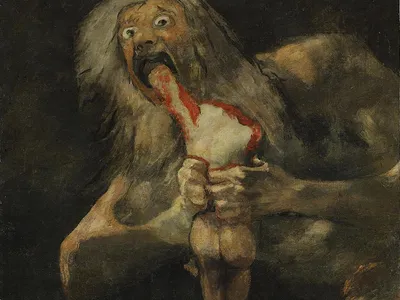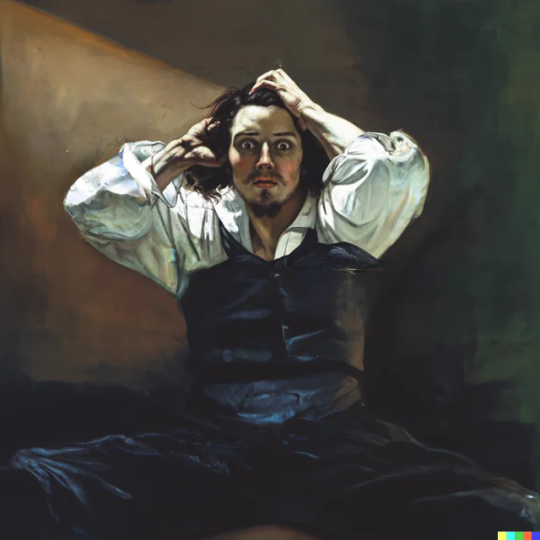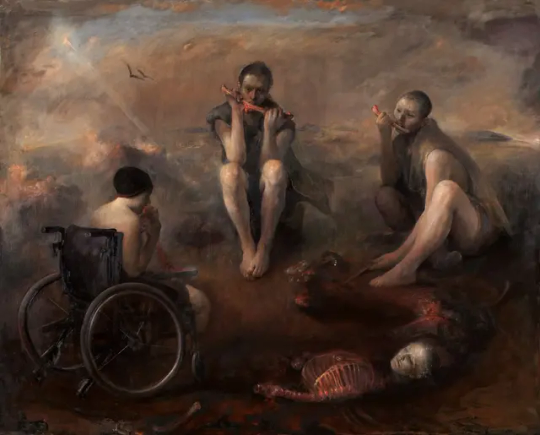#the flaying of marsyas
Explore tagged Tumblr posts
Text

Stupid fridge thing I never posted (TRANSCRIPT BELOW, FROM TOP LEFT TO BOTTOM RIGHT):
HANNIBAL:
Will,
Don’t forget the zenzai in the fridge.
Love,
Hannibal Lecter-Graham
WILL:
Hannibal,
Are you just going to use your full name in every note from now on?
—W.L.G.
HANNIBAL:
Will,
Why would I not? It’s my name.
Yours,
Hannibal Lecter-Graham
WILL:
Hannibal,
I forget how sentimental you can be.
Regretfully also yours,
W.L.G.
HANNIBAL:
Will,
Regretfully? But look how your own signature has evolved, beloved.
Ever tied to you,
Hannibal Lecter-Graham
WILL:
Hannibal,
Oh yes, because if nothing else, you’ve given me an extra letter.
Ever so grateful for your continued benevolence,
W.L.G.
(EXTRA):
ON THE SKETCH:
Please don’t remove this, Will. This is the only method I have at my disposal to withstand the endless dog slobber.
THE YELLOW STICKY NOTE BELOW THE SKETCH:
At least get a different magnet.
#yes I know the logic of leaving several notes over time on the same fridge doesn’t make sense…#the idea was this happens right after they get married#maybe I’ll make the sketch into a full piece#I headcanon Will’s handwriting to be a bit more loopy than displayed here#because of his signature on his badge and when giving consent to Chilton#but I like to think they both write in cursive#primarily#The Flaying of Marsyas#hannibal#nbc hannibal#will graham#hannibal lecter#hannigram#will graham art#hannigram art#will x hannibal#hannibal fanart#hannibal art
44 notes
·
View notes
Text

The Flaying of Marsyas (between c.1570-1576, oil on canvas) | Titian
#art#fine art#painting#oil painting#16th century#the flaying of marsyas#titian#mythological painting
38 notes
·
View notes
Text

THE FLAYING OF MARSYAS (1570-76) by TITIAN (TIZIANO VERCELLI)
This painting portrays a narrative from GREEK mythology in which a satyr, MARSYAS, contests the god Apollo in a musical competition, asserting that his music is superior to the god's. The aulos (a double flute) is played by MARSYAS, while APOLLO plays the lyre.
MARSYAS turned out to be a worthy adversary and he was victorious in the first round. However, in the second round, APOLLO inverted his lyre and played the same melody, which MARSYAS could not do with his aulos, and he was defeated.
The result is that MARSYAS is flayed by APOLLO, and TITIAN portrays MARSYAS hanging upside down from a tree, although the artist has altered the narrative slightly.
In the tree, the aulos is replaced by a pan flute, the female figure is positioned behind the kneeling APOLLO, the lyre is replaced by a LIRA DA BRACCIO, and the judge is replaced by the king of PHRYGIA, MIDAS, (the seated figure on the right, wearing a crown).
The inclusion of King MIDAS in the painting is likely a misinterpretation of a similar narrative of a musical competition between the two figures of PAN and APOLLO, wherein MIDAS serves as a judge. This is one of the most recent works of art created by TITIAN and is believed to be incomplete.
MARSYAS represents the pure DIONYSIAN aspect of art, which must be tamed by the blending of the APOLLONIAN aspect with it. From that union, TITIAN seems to be saying, true art, true wisdom, will come.
So that what at first appears to be a portrayal of a particularly cruel act of torture becomes, instead, a metaphor of transformation, and of ultimate harmony.
1 note
·
View note
Text

Apollo Flaying Marsyas
Artist: Dirck van Baburen (Dutch, c. 1595–1624)
Date: c. 1623
Medium: Oil on canvas
Collection: The Museum of Fine Arts, Houston, Texas, United States
Description
The painting shows the killing by flaying or skinning alive of Marsyas, a satyr who rashly challenged the god Apollo to a musical contest.
#mythological art#mythological scene#artwork#oil on canvas#painting#fine art#apollo#marsyas#male figures#violin#greek god#greek mythology#oil painting#figures#tree#nude figure#drapery#flaying#dutch culture#dutch art#dirck van baburen#dutch painter#european art#17th century painting#museum of fine arts houston
19 notes
·
View notes
Text

14 notes
·
View notes
Text





Apollo flaying Marsyas. On a typical day, one is terribly sympathetic for Marsyas, but when your ego is badly bruised, Apollo suddenly becomes quite relatable.
3 notes
·
View notes
Text


this comparison has really struck me for some reason you do see the "thief hearing strange noise in empty house" about him
1 note
·
View note
Text
Yellowjackets as famous artworks
Misty and Crystal as “Ivan the Terrible and His Son Ivan” by Ilya Repin:

Shauna and Jackie as “Saturn Devouring His Son” by Francisco Goya:

Lottie as “The Wounded Deer” by Frida Kahlo:

Doomcoming as “Fire Dance” by Joseph Tomanek:

Javi as “The Sacrifice of Isaac” by Michelangelo Merisi da Caravaggio:

Laura Lee as “Joan of Arc” by John Everett Millais:

Coach Ben as “The Desperate Man” by Gustave Courbet:

Natalie and her dad as “Judith Beheading Holofernes” by Michelangelo Merisi da Caravaggio:

The Jackie feast as “The Golden Apple of Discord” by Jacob Jordaens:

Shauna’s marriage as “The Reluctant Bride” by Auguste Toulmouche:

The team during the winter as “The Potato Eaters” by Vincent Van Gogh:

Travis during Doomcoming as “The Flaying of Marsyas” by Titian:

The card drawing as “The Execution of Lady Jane Grey” by Paul Delaroche:

Coach Ben witnessing the Jackie feast as “The Scream” by Edvard Munch:

Travis and Javi as “Anguish” by August Friedrich Schenck:

Tai and Van on the expedition as “The Dead Miner” by Charles Christian Nahl:

Shauna as “The Lunatic of Étretat” by Hugues Merle:

The final few survivors as “Cannibals” by Odd Nerdrum:

Natalie as “Death and the Soldier” by Hans Larwin:

The team and the Wilderness as “Self-Portrait with Death Playing the Fiddle” by Arnold Böcklin:

#alternatively: the last one could also be tai and “other tai”#but the team and the Wilderness as death itself looming over their shoulder felt distinctly more sinister#yellowjackets#yj#art#lottie matthews#taivan#jackieshauna#jackie taylor#shauna shipman#nat scatorccio#natalie scatorccio#travis martinez#javi martinez#javi yellowjackets#travis yellowjackets#natalie yellowjackets#misty quigley#crystal yellowjackets#taissa turner#van palmer#coach ben#classic art#classical art#laura lee#laura lee yellowjackets#rennaissance#rennaisance art#baroque#baroque art
2K notes
·
View notes
Text

Hey folks, this image of Apollo was done for a private commission. Xoxo
The following text is reposted from my previous Apollo Olympians image.
“Phoebus, of you even the swan sings with clear voice to the beating of his wings, as he alights upon the bank by the eddying river Peneus; and of you the sweet-tongued minstrel, holding his high-pitched lyre, always sings both first and last…And so hail to you, lord! I seek your favor with my song.” (-Homeric Hymn, translated by H.G. Evelyn white)
APOLLO (uh-PAH-low), God of prophecy, oracles, music, art, protector of and disease of boys and men, and archery. Just as his twin sister Artemis is patron to women and girls, Apollo is both protector, and killer from disease of boys and men. In my Illustration the god holds his bow and arrows behind, while he strums the lyre gifted to him by trickster Hermes. Near the sun flies his ally and divine messenger, a white raven. The column on the right is capped with a cow, representing his sacred animal as a god of herds. The serpent Python sits dead at his feet, killed by Apollo’s arrow so that the god could take over the Delphi temple location. The temple complex sits beneath the god, while on the far right, the Pythia (Apollo’s oracle priestess) sits upon a tripod, breathing the hallucinatory gasses seeping up from the earth to get her prophecies which she bestows upon visitors.
The laurel tree has associations with Apollo because the god, chasing a Naiad (water nymph) named Daphne call out to Gaia (mother earth) for help, who transformed the nymph into a laurel tree, which the god adopted as his sacred tree. In book 1 of the Iliad, Apollo supports the Trojans by raining down a plague on the Greeks, and later helping Paris to kill Achilles. Apollo’s cruelty is shown in Ovid’s mythical lyre contest with the inventor of the flute; a satyr named Marsyas. When Apollo suggested they play their instruments upside down, the satyr lost, and was flayed (skinned) alive as punishment for his hubris.
#pagan#hellenism#greek mythology#tagamemnon#mythology tag#percyjackson#dark academia#greek#greekmyths#classical literature#percy jackon and the olympians#pjo#homer#iliad#classics#mythologyart#art#artists on tumblr#odyssey#literature#ancientworld#ancienthistory#ancient civilizations#ancientgreece#olympians#greekgods#zeus#hesiod
4K notes
·
View notes
Text
Never take a Hellenic polytheist to a museum, they’ll spend all their time staring at the Greek statues…
So here are some pictures I took at the V&A today!

Temple of Bacchus, I was staring at this for a good 5 minutes

The 3 graces, they didn’t have the large one but I still loved seeing these (I actually got a pin and postcard of the usual statue that I love)

The sitting Venus, love love love it I wanted to just sit in front of it for hours

Eros and Psyche

Psyche by herself

Diana, missing her bow sadly

Zephyr and Flora, for the few Zephyr worshippers I see here

Apollo flaying Marsyas

Thetis dipping Achilles in the river Styx

The best photo I took today, it had depictions of Apollon, Zeus and some other gods around the room and was lovely
#hellenic deities#hellenic devotion#hellenic gods#hellenic polytheism#hellenic polytheist#hellenic polythiest#hellenic worship#hellenic pagan#hellenic paganism#hellenism#hellenic pantheon#hellenic titans#aphrodite deity#aphrodite#zephyr#venus#Artemis diana#artemis#psyche#eros and psyche#dionysus deity#bacchus
160 notes
·
View notes
Text




Statue of Marsyas, Roman copy of Greek original sculpture. First century BCE. Capitoline Museums
The monumental statue represents the silen Marsyas hanging on a tree, waiting to be flayed upon order by Apollo. The white-and-red Pavonazzo marble was likely used to emphasize the effect of the flaying.
66 notes
·
View notes
Text
Some recent discussions I’ve seen about EPIC: The Musical, The Trials of Apollo, and Greek Mythology itself have prompted me to make this post.
With me, at least, when I’m talking about one of the Greek gods, I’m talking about them as they are portrayed in a specific thing.
It’s the same in my fanfics— I would not portray mythology Apollo the way I do ToA Apollo, and vice versa.
A good example of this I think would be my Marsyas fic. In it, I do not have Apollo flay him, because that makes more sense in the rrverse world. If I was going purely on the myths though? I would have had him go through with it. And have a crisis about it. Because that’s what happens.
I just wanted to put it out there that there are people capable of keeping different depictions of the gods separate from the myths. I felt the need to come out and say this, because I don’t want people thinking that my favorite media’s fandom (ToA) ignores/misportrays the myths. We are very aware of what is ToA and what is myth, and I want to set that straight.
Plus, I think it’s worth mentioning that some people in the ToA fandom connect so deeply with it because of the themes of change and the cycle of abuse. And for that to work, the gods have to be more dysfunctional than they are in the myths. It wouldn’t hit as hard if they weren’t.
idk. I just feel like there’s some layer of…hm, instinctual dislike towards fandoms of medias with Greek myth inspiration, because of certain inaccuracies and how that consequently reflects on the myths.
And I didn’t really like seeing that directed at ToA’s fandom, where we have fun discussing the differences between the rrverse and mythology and do in fact keep them separate. I’d argue the ToA fandom’s the most informed on the Greek myths in the wider rrverse fandom because we’re actually interested in the gods. Many have read the myths, or are reading them, like myself! We are educating ourselves on the mythology! And when we find something that has an interesting vision because of ToA’s context? We incorporate it into the setting of the rrverse. But we do not treat that vision as mythology canon.
A very good example of this is Zeus and Apollo’s relationship in ToA. It’s a stark contrast to the myths. I get why people wouldn’t be a fan of that. I like learning about their mythological relationship myself! I love the Greek myth soap opera. I love the Greek gods. I don’t know why someone would be into the mythology without liking the gods.
But I also feel like there needs to be an understanding that how the gods are portrayed in fictional stories are not always intended to be accurate. There are creators out there who treat their retellings as gospel truth, and that is definitely annoying, but there are others who just want to tell a story— and that’s what ToA is. A story. It’s essentially an AU of Greek mythology where Zeus succumbs to paranoia about the cycle. That’s how I see it.
It’s not accurate to the myths, because it’s not meant to be— it’s meant to tell a story, not retell one.
I’m beating a dead horse here because I’ve talked about this specific thing before. But yeah.
Just something I wanted to clear up with the mythology side of tumblr.
#anyway plz don’t crucify me#i hate discourse I hate confrontation I am literally so anxious about this.#the trials of apollo#greek mythology#trials of apollo#percy jackon and the olympians#the heroes of olympus#heroes of olympus
126 notes
·
View notes
Note
Knowing Apollo's history with Satyrs i'll just add that he probably flayed one because he wrongfully bragged abt bedding Perse (since she's a goddess known for being incredibly beautiful who doesn't smite people all that much)
Apollo about to make Marsyas story sound like a fairytale
74 notes
·
View notes
Text

-Marsyas Flayed by Apollo-
77 notes
·
View notes
Text

Apollo and Marsyas
Artist: Hans Thoma (German, 1839–1924)
Date: 1888
Medium: Oil on panel
Collection: Art Institute of Chicago, Chicago, IL, United States
Description
Along with Arnold Böcklin, Hans Thoma was a leading Northern European figure in the shift from Realism and history painting to art inspired by classical myths and legends. Taken from Ovid’s epic poem Metamorphoses, Thoma showed the satyr Marsyas challenging Apollo, the master of the lyre, to a musical contest. Although he avoided depicting the cruel outcome of the match (the satyr lost and was flayed alive by Apollo), the artist’s treatment of Apollo, whose idealized body and luminous skin set him apart from the shadowy halftones of his challenger, hints at the winner.
#mythological art#mythological scene#painting#oil on panel#apollo#marsyas#landscape#mythological figures#ovid's metamorphoses#epic poetry#literature#satyr#musical contest#lyre#nude figures#fine art#artwork#oil painting#german culture#german art#hans thoma#german painter#european art#19th century painting#art institute of chicago
57 notes
·
View notes
Note
Does Apollo wear sun crown in mythology? I'm thinking to give him a crown like that in my design but idk if that is correct or not I wanna make sure.
Anon, first of all I want to say that if you really wish to give Apollo a sun crown in your design, you should just go ahead and do it. I mean, a lot of Hermes fandesigns I've seen lately have his entire face covered in wings lol. So like, go wild. It's your art, draw what makes you happy.
To answer your question, I haven't ever read of Apollo wearing any such sun crown in the classical literature. But, we do have a few depictions of Apollo with a radiate head.





King Antiochus l shakes hand with Apollo. The deity is wearing a laurel wreath and holding a laurel sprig - attributes exclusive to Apollo, so we know it's not Helios/Sol (at least not entirely)
From a Roman fresco picturing a beauty contest between Venus and Hesperus, with Apollo as the judge.
A fragment of kithara. On the left, a Scythian is preparing his knife to flay Marsyas. On the right, Marsyas' toes are visible. Given that this is a kithara and that the events from Marsyas' story is depicted, the central figure is most probably Apollo-Helios.
A coin depicting Apollo Lairbenos from Hierapolis
A coin depicting Apollo Archegetes from Hierapolis
You can actually find more coins of Apollo Lairbenos with a radiate head. Such depictions of Apollo are quite rare, as you can see, and it was clearly a result of his syncretism with Helios. So if you're aiming for mythical accuracy in your design, I'd say you wouldn't be wrong to draw Apollo with a sun crown/radiate head, although you would be going with a very uncommon depiction.
40 notes
·
View notes